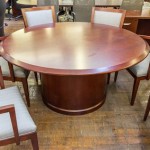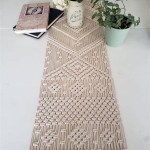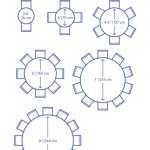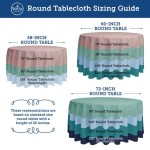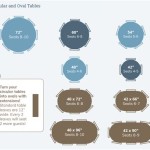Seating Plan Strategies for Round Tables
Creating a seating plan is a fundamental aspect of event organization, whether it's for a wedding reception, a corporate gala, a fundraising dinner, or even a large family gathering. The thoughtful arrangement of guests can significantly impact the overall atmosphere, fostering conversation, engagement, and enjoyment. When the chosen table configuration involves round tables, specific considerations become particularly relevant. Round tables inherently encourage interaction, but optimizing that interaction requires careful planning.
The geometry of a round table lends itself to inclusivity, allowing all seated guests to see each other. This promotes a sense of connection and makes it easier to participate in group conversations. However, this very openness also presents challenges. Without deliberate consideration, conversational dynamics can become disjointed, or certain individuals might feel overshadowed. A well-executed seating plan for round tables addresses these potential pitfalls and maximizes the opportunities for positive interactions.
Factors to consider when developing a seating plan for round tables include the number of guests, the size of the tables, the relationships between guests, and the overall objective of the event. A smaller, more intimate gathering might prioritize placing close friends and family members together. A larger corporate event, on the other hand, might focus on strategically mixing individuals from different departments to facilitate networking and collaboration. Regardless of the event type, a strategic approach ensures that guests feel comfortable, engaged, and have a positive experience.
Key Point 1: Understanding the Dynamics of Round Table Seating
The inherent nature of round table seating establishes a different set of social dynamics compared to rectangular or linear configurations. The absence of a head table or a clear hierarchical arrangement implies equality among the seated guests. This can be a powerful tool for promoting inclusivity and encouraging participation from everyone at the table. However, it also means that there is no natural focal point or individual designated to lead the conversation. The dynamic emerges organically based on the individuals present and their existing relationships.
Careful consideration must be given to the personalities and conversational styles of the guests being seated together. Placing individuals with similar interests or shared experiences can spark engaging conversations. Conversely, avoid placing individuals with known conflicts or vastly different perspectives next to each other. While a degree of social mixing can be beneficial, a poorly chosen pairing can create discomfort and negatively impact the overall atmosphere of the table.
The proximity of guests to each other also plays a crucial role. Guests seated directly next to each other will naturally have more opportunities for interaction. Therefore, these positions should be reserved for individuals who are likely to have a positive connection. Guests seated further apart might have less direct interaction, but they are still part of the overall table dynamic. Consider balancing the table by placing individuals with different conversational styles around the perimeter.
When planning seating arrangements, the visual landscape should not be overlooked. Consider the line of sight to key features in the room such as the stage, the head table (if present), or prominent decorations. Try to distribute these vantage points evenly amongst the tables, ensuring that everyone has a clear view of the important elements of the event.
It is also prudent to consider any physical limitations or special needs of the guests. Guests with mobility issues should be seated in locations that provide easy access to the table and nearby amenities, such as restrooms or exits. Guests with hearing impairments should be seated away from noisy areas, such as speakers or musicians, and positioned in a way that allows them to easily see and hear other guests.
Key Point 2: Strategic Placement of Key Individuals
While round tables tend to equalize the seating arrangement, strategic placement of certain individuals can still have a significant impact on the overall dynamic of the table. These "key individuals" might be hosts, honorees, or particularly influential guests whose presence is intended to shape the flow of conversation and create a positive atmosphere.
The host(s) of the event should be strategically placed to ensure they can effectively interact with all guests at their table. This often means positioning them between individuals who might not know each other well, or between individuals with differing personalities. The host can then act as a facilitator, guiding the conversation and ensuring that everyone feels comfortable and included.
If the event is honoring a specific individual or group, their placement deserves special consideration. Placing them at a table with close friends, family members, or colleagues can create a supportive and celebratory atmosphere. However, depending on the nature of the event, it might also be beneficial to place them at a table with individuals who represent different facets of their life or work. This can allow them to share their experiences and insights with a wider audience.
In a corporate setting, strategic placement of senior executives or influential figures can have a powerful impact on networking and collaboration. Placing them at tables with junior employees or individuals from different departments can foster communication and break down hierarchical barriers. This can create opportunities for mentorship, knowledge sharing, and the development of new ideas.
It is important to remember that the placement of key individuals should always be done with sensitivity and respect. Avoid creating the impression that some guests are more important or deserving than others. The goal is to create a positive and inclusive atmosphere for everyone at the table, while also leveraging the presence of key individuals to enhance the overall experience.
Key Point 3: Tools and Techniques for Creating Effective Seating Plans
Creating a seating plan can be a complex undertaking, particularly for large events. Fortunately, a variety of tools and techniques are available to streamline the process and ensure that the final arrangement is both strategic and efficient. These range from simple pen-and-paper methods to sophisticated software applications.
A fundamental technique is to create a visual representation of the seating arrangement. This can be done using a simple diagram of the room layout, with circles representing the round tables. Each table can then be filled in with the names of the guests assigned to that table. This visual representation allows for easy review and adjustments, making it simple to identify potential problems or opportunities for improvement.
Index cards or sticky notes can be used to represent individual guests. These can then be moved around on the visual representation of the seating arrangement, allowing for flexible experimentation with different combinations. This method is particularly useful for visualizing the relationships between guests and identifying potential conflicts or synergies.
Spreadsheet software, such as Microsoft Excel or Google Sheets, can be used to create a more structured representation of the seating plan. Each row in the spreadsheet can represent a table, and each column can represent a seat at that table. This allows for easy sorting and filtering of guests based on various criteria, such as their relationship to the host, their interests, or their dietary restrictions.
Specialized seating plan software applications offer a range of advanced features, such as automated guest matching, conflict detection, and visual drag-and-drop interfaces. These applications can significantly streamline the planning process, particularly for large events with complex seating requirements. Many of these applications also integrate with other event management tools, such as ticketing systems and RSVP platforms.
Regardless of the tool or technique used, it is essential to involve stakeholders in the planning process. Soliciting input from family members, colleagues, or event organizers can provide valuable insights and ensure that the final seating plan reflects the needs and preferences of all involved. It is also important to remain flexible and adaptable, as unexpected changes or last-minute cancellations may require adjustments to the seating plan. The ability to respond quickly and effectively to these changes is a crucial skill for any event planner.
Finally, it is crucial to communicate the seating plan clearly and effectively to the guests. This can be done through place cards at each table, a printed seating chart displayed at the entrance to the event, or a digital seating map accessible via a mobile app. Clear communication helps to reduce confusion and ensure that guests can quickly and easily find their assigned seats, contributing to a smooth and enjoyable event experience.

Wedding Seating Plan Template Planner

Party Center

Free Table Seating Plan Templates

8 Person Round Table Seating Chart

Printable Wedding Table Seating Chart Template Round Planner Event Arrangement Head Plans Seat Map

19 Great Seating Chart Templates Wedding Classroom More

Blank Wedding Seating Charts 10 Free Printables Printablee

Free Table Seating Plan Templates

Wedding Seating Chart 80 Pax Round Table Display For Guest Names Organisation Planner Book Plan

16 Table Seating Chart Templates Doc Excel
Related Posts

